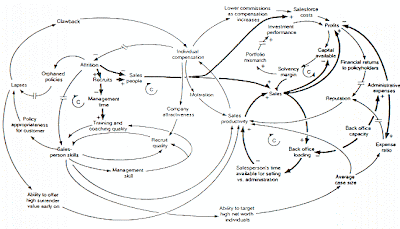25.3.10
24.3.10
22.3.10
Smithsontag

The monument is the marker that stands, that stands in for something else. It holds a place with a crystalline perlocutionary desire. This desire is to imprint a stilling, a melancholy gape, and a desire that this stilling should be iterative, self perpetuating. We can claim that monuments desire.  Smithson is excited by the first structure that meets his criteria, that feels wrong and romantic enough to be a distraction from the deadlands. He pulls the buzzer-cord and gets off at the corner of Union Avenue and River Drive. The sunlight is so bright that it makes him squint, and framed collapsing into a narrow band by his eyelids he processes the whole thing into cinemascope. The whole landscape has always already been an image, whited out.
Smithson is excited by the first structure that meets his criteria, that feels wrong and romantic enough to be a distraction from the deadlands. He pulls the buzzer-cord and gets off at the corner of Union Avenue and River Drive. The sunlight is so bright that it makes him squint, and framed collapsing into a narrow band by his eyelids he processes the whole thing into cinemascope. The whole landscape has always already been an image, whited out. 
Now when he speaks he speaks only of the image of the wooden boarded bridge, footsteps re-emerge like shutter clicks, dragging the time of a journey back into the image set about replacing itself slowly as an image, a series of images. The photograph itself does not concern itself particularly with the landscape - it is documentary, it is the least of the document, the least of the structure slinking away beneath the text that replaces the beams, the river it spans, unseen, sand boxes in the distance. What is an archive but a dead thing, arranged, picked over? 
Sound creeps in - there is debris rattling in a pipe. There is an incidental language bubbling in the space just beyond the city proper.
We stand in a sea of afters, twisted into shape.
19.3.10
notes on white, i

There is so much silence here, where there needn't be. Lapses soar upwards to clawback and swoop to individual compensation, which bursts into whorls that loop into lapses, and backwards, and so on, and on. The language is thin, the lines are thin, the crosses tiny.
Betty Leirner bisects the projection screen with the thin line between the broad white stripe below, and the lovers above*. They are slim-legged and static, occasionally shifting their weight, at moments locked in an unnatural stillness… but time is marked with swift certainty by the frenzied flow of the river that moves around them. 
Now, in my work, white appears twice, working on the image in axes of formal, spatial compression and as a temporal wash that gives the image slowly so the eye cannot be certain when it has arrived, or when it will be swallowed in a smooth salted bleaching.
This is often snapped off because it is not a true tide.
Around the edges is it is a present absence.
Leirner says:
To leave the screen half empty opens a space inside the film for the absence of ideas she has, and opens up that space for viewers to project their own ideas. Light is a third constituent of PhotoFilm – denoting the emptiness of the synthesis of photo and film.**
The image grows diagonally to fill the whole screen, and loses its intensity.
For me the decision is more interested in the image it contains – its edge.
There are two sets of edges in a film – the one becomes more defined, and the other, less.
Chris Marker, speaking through the lips of a female narrator said:
The first image he told me about was of three children on a road in Iceland, in 1965. He said that for him it was the image of happiness and also that he had tried several times to link it to other images, but it never worked. He wrote me: one day I'll have to put it all alone at the beginning of a film with a long piece of black leader; if they don't see happiness in the picture, at least they'll see the black.
To begin with the black is voiced, and the image is silent.
They will see it twice, the first time until it is named as leader, given a syntactical purpose, and the second time as a challenge to see it as an object that is seen, rather than not seen.
The screen turns black again and the voice continues: 'He said for him it was the image of happiness. And also that he had tried several times to link it to other images.' A shot of an aircraft carrier replaces the black and the voice states: 'But it never worked.' It is this image mismatch that introduces the project of Sans Soleil, the project of finding corresponding images that will connect successfully to one another. The entire film is marked by this effort to successfully link one image to another image.[5]
Hollis Frampton's Zorns Lemma begins in the hard-female-voiced black of sequential instruction. Time is marked with rhyming pairs from the Bay State Primer, which Scott MacDonald has claimed is analogous with the state of childhood as 'a period of near stasis during which nothing of importance is seen and almost nothing understood' emerging from which 'the development of verbal skills doesn't destroy visual innocence; it releases the child from the prison of ignorance and indoctrination.'
The third and final section of the film is a couple and dog walking with laboured footsteps away from the camera into a static snowy landscape, voiced over by the awkward sequential chorus of the human voice aurally fused with a metronome to produce a single word per second, one voice after another. The phonemes and syllables of Grosseteste's treatise**** grapple towards the beat, attempting to disappear inside it.
Now, Scott MacDonald brings me to the white, which doesn't exist in the version on Ubu, linked above:
…After the reading of the passage from Grosseteste is complete, the film continues for a minute or so more: The man, woman, and dog reach the distant woods and enter, and after a moment the screen flares to white. Given its position within the structure of Zorns Lemma, the moment when the walkers enter the woods is certainly suggestive of …[a]nd the flare-out to white not only signals the end of the roll and the film, it is suggestive of the widespread observation by those who have had near-death experiences that, at the moment of death, we see a powerful light.
Finally, since Frampton may have assumed that the coming of the light at the end of Zorns Lemma would be followed by the lights coming on in the theater and the audience filing out, the exit of the man, woman, and dog from the field is not only echoed by the viewers' exit from the cinematic incarnation, but is prescient of our ultimate exits from life, and the concluding moment of our intellectual growth.
So, if this white is a fiction, an accident, it is still useful. It is perhaps because of this, at this stage, this point, that I decide to take up a position here – if there is this movement into white, then what exists in the landscape after the fade? The voice must remain to make sense of the images – to bind them, as they are empty, and then can exist only of hard and soft architecture, left over, that bleed in and out of white. It speaks of systems that grew and then were arrested...
Frampton writes: Our white rectangle is not 'nothing at all.' In fact it is, in the end, all we have. That is one of the limits of the art of film.
So if we want to see what we call more, which is actually less, we must devise ways of subtracting, of removing, one thing and another, more or less from our white rectangle. 

Ingmar Bergman Persona, 1966
Bergman draws in the nebulous edges of an antique film. It is framed small, and peered at intimately, like a specimen.
There is the drawn out descent of the image of a face into obscurity, eye shine remaindered, briefly. An image hangs back.
----------------------------------------------
* Leirner (2000). Lovers. [DVD].
Two cranes stand motionless with their long limbs penetrating a hysterical surface of fast moving water. It consists of a single shot that tracks slight shifts back and forwards of the birds for 4 mins.
Leirner refers to her work as FotoFilm, and was featured in the recent PhotoFilm! season screened at Tate Modern. She has shown the film with five different soundtracks, but in the version I saw it was the fattened continuous sound of a hive of bees, which distended the pace of water into a pronounced discomfort.
** This is at best an approximation of the words that Leirner spoke in relationship to the work, scribbled in a leaflet, but not too far away.
*** The large middle section of the film consists of the 24 frame cut of an advancing Roman alphabet (which has only 24 letters, combining i/j and u/v to allow for the structures to sit inside one another) in words filmed in an urban environment, the first letter of each advances in a smooth cycle. Each letter is gradually replaced with 24 frames of a moving image.
**** A 13th C. text that attempt to understand the perceivable world as symbol produced by the spiritual, and generation and fundamental nature of the physical world in terms of the action of light
[5] Kodwo Eshun, from an interview, p.76 in 'THE OTOLITH GROUP: A Long Time Between Suns', Sternberg Press, Berlin/NY 2009 
18.3.10
14.3.10
10.3.10
8.3.10
Varda - Salut les cubains (1962-63)
I am watching the excellent PhotoFilm! season at Tate Modern, curated by Gustáv Hámos, Katja Pratschke and Thomas Tode.
Labels: agnes varda, cuba, film, photography
7.3.10
harems
Car rides in and out of hissing sunlight would stink like baked leather and cigar ash, and none of the trio whose thigh-backs stuck to the back seat really ever wanted to know about the archives swelling like corpses in the trunk.
They consisted of one thing, immediately troubling: small pink fields of numbers censored out in sixes.
The second thing, which was less immediately troubling but now forms something more uncertain, was the fact that he liked to take photographs of supermarket checkout girls. With disposable cameras. He favoured one particular supermarket where they wore mint green vests and pink neckties, hovered behind checkouts and deli counters trading goods. All were smiling, smiling at the old man.
It didn’t particularly seem to matter what age, what ethnicity they were, whether they were attractive by any magazine standard, but there was always the same type of building, the same binding system of smiles: humorous, uncertain, pleading, calm.
Other collections included broken pens and thousands of unused condoms yellowing in the pockets of cheap suits. It was certain that at the very least seriality was in, and so was optimism.
Labels: photography, series










